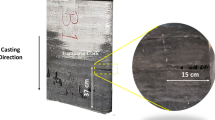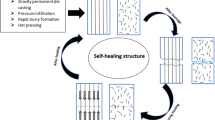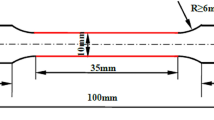Conclusions
As a result of a fractographic investigation of fracture surfaces of Mg/steel, Mg/B, Al/steel, and Al/B composites it was established that during the extension of a composite material consisting of a ductile matrix and ductile fibers (e.g., Mg/steel or Al/steel) in the temperature range 20–400°C the matrix fails in a tough manner and no significant changes are observed in the morphology of structure of its fracture. The fracture of the fibers occurs with waist formation. Raising the testing temperature intensifies the processes of plastic flow in the fibers, and the latter can therefore be regarded as playing a dominant role in the fracture of the material as a whole. In a composite material consisting of a ductile matrix and brittle fibers (e.g., Mg/B or Al/B) the matrix ruptures in a tough manner while the fibers fail in a brittle manner, by cleavage. At higher testing temperatures the matrix deformation processes become intensified, in consequence of which the fibers experience multiple fractures and the strength of the material falls.
Similar content being viewed by others
Literature cited
C. A. Zweben, “Bounding approach to the strength of composite material,” Eng. Tract. Mech.,4, No. 1, 1–8 (1972).
M. Kh. Shorshorov, L. M. Ustinov, L. V. Katinova, et al., “Investigation of the fracture characteristics of fibrous aluminum/steel and aluminum/boron composites with the scanning electron microscope,” Fiz. Khim. Obrab. Met., No. 1, 114–118 (1976).
G. C. Sih, P. D. Hillon, and R. Badaliance, “Fracture mechanisms for fibrous composites,” in: Testing Methods for High-Modulus Fibers and Composites, Philadelphia, Pa. (1973), pp. 98–132.
T. Vasilos and E. G. Wolff, “Strength properties of fiber-reinforced composites,” J. Met.,18, No. 5, 583–592 (1966).
V. S. Ivanova et al., Fiber-Reinforced Aluminum and Magnesium Alloys [in Russian], Nauka, Moscow (1974).
Fracture [Russian translation], Vol. 1, Mir, Moscow (1973).
Author information
Authors and Affiliations
Additional information
Translated from Poroshkovaya Metallurgiya, No. 2(206), pp. 87–90, February, 1980.
Rights and permissions
About this article
Cite this article
Karpinos, D.M., Kadyrov, V.K., Gordienko, A.I. et al. Scanning electron microscopical investigation of the fracture of reinforced magnesiumand aluminum-base composites. Powder Metall Met Ceram 19, 141–144 (1980). https://doi.org/10.1007/BF00792045
Received:
Issue Date:
DOI: https://doi.org/10.1007/BF00792045




